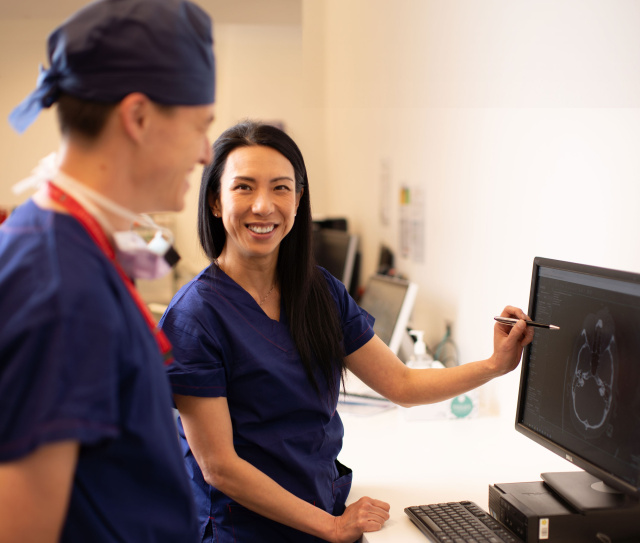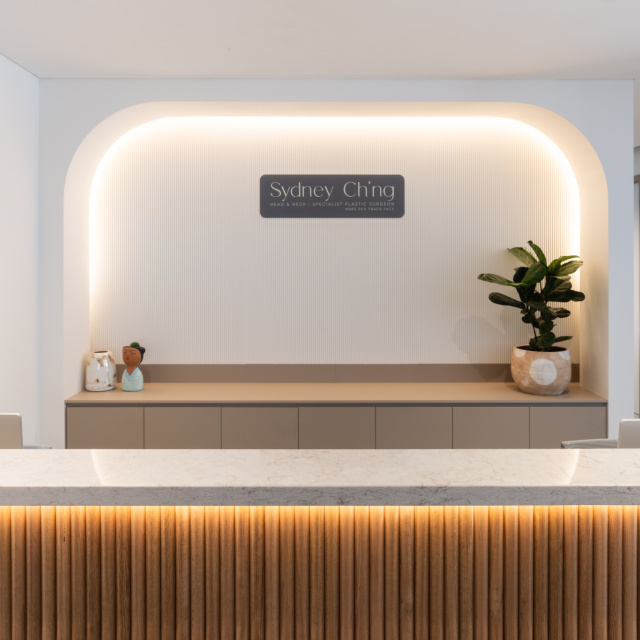Parotid tumour surgery
The parotid glands are large salivary glands located just in front of the ears. There is one parotid gland on each side of the face. The facial nerve and its branches traverse the parotid gland. A parotid tumour is an abnormal growth of cells within a parotid gland. Surgery on the parotid glands (parotidectomy) is one of Dr Sydney Ch’ng’s most requested procedures.

WHAT ARE PAROTID TUMOURS?
Parotid tumours, or salivary gland tumours, are growths of abnormal cells in the gland, or in the duct that drains the salivary glands.
While relatively uncommon, there are three main symptoms that are experienced with parotid tumours:
Swelling in the face and jaw (usually painless, and by far the most common)
Loss of facial movement (this can indicate a serious diagnosis)
Difficulty swallowing (very rare)
Dr Sydney Ch’ng is a Sydney-based surgeon who performs superficial and total parotidectomy surgery for the removal and treatment of parotid gland tumours.
TYPES OF PAROTID TUMOURS
Most parotid tumours are benign (non-cancerous). Benign tumours include:
pleomorphic adenoma (most common)
Warthin’s tumour (occurs commonly in older men who smoke)
oncocytoma and other rare tumours
Some parotid gland tumours are malignant (cancerous). This is especially true in Australia due to our high rates of skin cancer, which can spread from the face to lymph nodes around and within the parotid gland.
Malignant tumours include:
metastasis from skin cancers
high and low-grade mucoepidermoid carcinoma
salivary duct carcinoma
squamous cell carcinoma
acinic cell carcinoma
adenoid cystic carcinoma
Parotid tumours are diagnosed following an ultrasound-guided fine needle aspiration (FNA) in which cells are removed for testing. Imaging, such as an MRI or CT scan may be used to check the size of the tumour and whether it has spread to nearby tissue or lymph nodes in the neck, or involved the facial nerve.
HOW ARE PAROTID TUMOURS TREATED?
Parotid surgery, also known as a parotidectomy, is the standard form of treatment for most parotid tumours and involves the removal of part or whole of the parotid gland. Depending on the size and severity of the tumour, parotidectomy surgery by convention is categorised as either superficial or total.
Superficial Parotidectomy
A superficial parotidectomy is used when the tumour growth is limited to the superficial lobe of the parotid gland. During the procedure, all or a part of the affected superficial lobe is removed, along with some surrounding tissue.
Total Parotidectomy
For parotid tumours located in the deep lobe of the parotid gland, a total parotidectomy may be recommended in order to remove the deep lobe and, if necessary, part of the superficial lobe (usually for access).
In both types of parotidectomy surgery, protection of the facial nerve is critical. The facial nerve traverses the middle of the parotid gland and is responsible for frowning, eye closure, nose wrinkling, smiling, and lip movement. During surgery, Dr Ch'ng uses nerve integrity monitoring (NIM) – a device that allows her to monitor the function of the facial nerve during surgery. This ensures that the nerve is protected and minimises the risk of resulting weakness in the facial muscles. In exceptional circumstances, this is impossible due to the location or size of the tumour.
For cancerous parotid tumours, radiotherapy may be used following surgery to decrease the risk of the cancer coming back. Immunotherapy or targeted therapy may have a role in advanced parotid cancer that cannot be removed with surgery.
EFFECTIVE PAROTID TUMOUR SURGERY & REMOVAL IN SYDNEY
If a parotid tumour is small and non-cancerous, Dr Ch’ng may be able to perform the surgery through a mini-face lift incision. She can also correct any contour deformity in the cheek or upper neck following removal of the tumour with fat transferred from another part of the body (this is called dermofat or a fat graft). The scar will be inconspicuous.
A small drain is usually inserted into the wound to drain body fluid and blood from the wound site. The drain is usually removed before you are discharged from hospital. You will remain in the hospital for 2 nights.
Frequently Asked Questions
Dr Ch'ng's most frequently asked questions regarding parotid surgeries.
-
Yes, parotid tumour surgery, or a parotidectomy, is a major surgery. The surgery generally lasts three to four hours, and you will likely have to stay in hospital for 1 - 2 nights. The surgery involves removing the benign or cancerous tumour in the parotid gland (large salivary glands on each side of the face), and then potentially reconstructing the area.
-
For a malignant tumour, parotid tumour surgery can prevent the cancer from spreading. For benign tumours, surgery will prevent the tumours from becoming larger or transforming into cancer. Removing the parotid tumour when it has become too large puts the facial nerve at higher risk of injury. The facial nerve within the parotid gland allows the face to smile or frown, chew and swallow.
-
Yes, you can live with just one parotid gland. A parotid gland is a major salivary gland that creates 10% of the saliva in the mouth which helps kick start digestion, assists in chewing and swallowing food and protects the teeth. However, you still have other major salivary glands to support these functions.
Get in touch
If you’d like to know more about our head and neck, plastic or skin cancer surgical services, or if you have a question for Dr Ch’ng, we’d love to hear from you.
